The last section of Chagigah veers away from mystical topics to very concrete ones, albeit ones that are foreign to modern ears. We begin to discuss issues of purity and impurity, something that occupies a good deal of space in rabbinic literature. This is a great opportunity for a short introduction about pure and impure materials and what evidence we have found of them in archaeology.
The second half of the middle chapter of Chagigah leads us into the topic of purity with a conversation about washing hands (Chagigah 18b). From there we learn about impure fabrics and vessels. The Gemara also discusses the gradations of purity required for different types of food: hullin (everyday food) terumah (tithes) kodashim (sacrifices) (20b) and others, as well as the strictness of different types of people (amei haaretz, perushim, kohanim). Purity was a passion in Second Temple times, as the Gemara tells us פרצה טהרה בישראל, purity was widespread in Israel (Shabbat 13a). But how did these purity laws work in everyday life?
Impurity occurs because of a direct or indirect contact with death – a dead body, a dead animal, or other forms of non-life. Different materials have different laws regarding purity and impurity. Most materials: metal, wood, fabric, leather – can become impure but they can also be purified in the waters of the mikveh. This is derived from a verse in the Torah:
“Gold and silver, copper, iron, tin, and lead— any article that can withstand fire—these you shall pass through fire and they shall be pure, except that they must be purified with water of lustration; and anything that cannot withstand fire you must pass through water.” (Bamidbar 31:22-23)
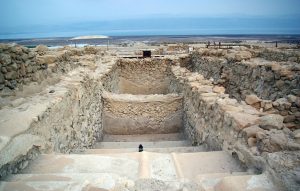
One of the many mikvehs in Qumran
Berthold Werner, Public domain, via Wikimedia Commons
Stone vessels on the other hand never need to be immersed in the mikveh because they never become impure. And the most common material of all, clay (what pottery is made of) has the strangest rules. If it becomes impure it can never be purified. The only way it can be used again is by rendering it useless through breaking it or making a big hole in it. However, unlike the other materials (except stone) impurity can only enter a clay vessel through an opening, not by touching the outside of the vessel. What this means in practical terms is that if the pottery is tightly sealed with something that cannot become impure, the food and drink inside stays pure. Contrast that to a metal jug whose contents automatically become impure if it is in the room with a dead body. (derived from Bamidbar 19:15)
What does archaeology have to say about all this? In the last seventy years or so we have excavated many late Second Temple sites and they offer tantalizing details about everyday life. The first and most obvious finds are the many stone vessels. Stone cups and dishes have been found in Masada and Qumran, in Jaffa and in many other Second Temple Jewish communities. They are most prevalent in the beautiful priestly homes in Jerusalem, whose owners were both wealthy and very concerned about purity. Stone is difficult to manipulate and expensive to quarry. Besides the prestige of owning a long lasting, beautiful stone cup, why else would you bother? Because stone is a good investment. It never becomes impure and so will be able to be used for a long time. The classic vessel we see is what is called a measuring cup, although it could just as easily have been a coffee mug (tragically coffee had not been discovered yet).
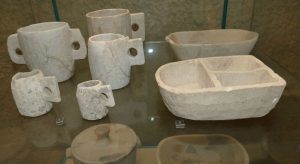
Stone cups from the Herodion Quarter
Bukvoed, CC BY 4.0 <https://creativecommons.org/licenses/by/4.0>, via Wikimedia Commons
Stone was great but not everyone could afford it and it did not work for all purposes. Despite its disadvantages, pottery remained ubiquitous, as it had been for centuries. In the Herodion Quarter there were many pottery jars and pots. A curious group of them was found in a pile in a cistern. Many had a small hole in them., Could these have been pots that had become impure and were made “unusable” with a small hole, so that they could be used again? Perhaps.
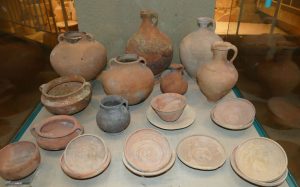
Pottery from the Herodion Quarter
Bukvoed, CC BY 4.0 <https://creativecommons.org/licenses/by/4.0>, via Wikimedia Commons
We also find evidence of the צמיד פתיל, the stoppers used to close up pottery jars so that impurity cannot enter them. Although they can be made from many different materials, we find some made from stone in the Herodion Quarter. Why from stone? Because they were a by product of making stone cups. The extra that was scooped out was used to make small items like stoppers and weights.
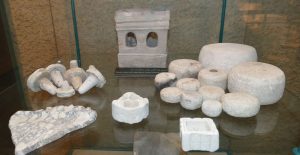
Bukvoed, CC BY 4.0 <https://creativecommons.org/licenses/by/4.0>, via Wikimedia Commons
All this was fine for the wealthy priests of Jerusalem who could afford any dishes they wanted. But it is fascinating to see that even the refugees at Masada took care to bring their stone dishes with them. At Masada we also got another look into how important purity was to our ancestors, even in the most difficult circumstances. Some of the pottery vessels have writing on them. Some have a simple letter: ת or ט. According to Yigael Yadin, the first Israeli excavator of the site, these signified תרומה, tithe for the priests, or טבל, untithed produce. There were also longer inscriptions that included variations on טהור, pure, and קדוש, sanctified. Far from the Temple, the priests still took care to eat tithed food and the ordinary people made sure to eat their regular food in purity.
In order to ensure purity you needed to have ritual baths, mikvaot, Of course these were all over Jerusalem, in public areas near the Temple as well as in people’s private homes. We also find them in Qumran, where the residents had multiple mikvaot despite the scarcity of water in the desert, and in Masada. If you needed to be careful about the vessels holding your food, you also needed to watch your own status and not eat sanctified food when you are impure. Besides going to the mikvah, the rabbis instituted the idea of immersing your hands before eating holy things, and even for hullin, unsanctified food (Hagigah 18b), Dr, Yoel Elitzur suggests that the very shallow mikvaot found in Masada and in one of the houses of the Herodion Quarter were not meant for full body immersion. While halachically possible, it would have been uncomfortable. He thinks that they were used to immerse just your hands before eating, as the rabbis prescribe.
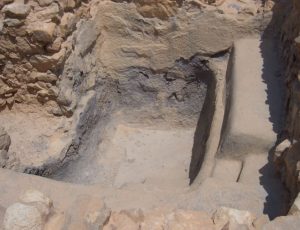
Masada mikve
Public domain, via Wikimedia Commons
While some rabbinic discussions seem difficult to picture in real life, the issues of purity and impurity were deeply rooted in the reality we find in archaeology.
Thanks to Barnea Selavan and Hillel Geva for their input.










